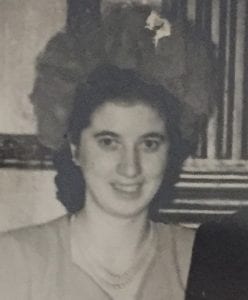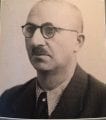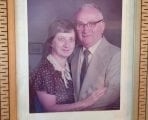- Local Survivor registry
- LISELOTTE ROSENTHAL
- Local Survivor registry
- LISELOTTE ROSENTHAL
Survivor Profile

LISELOTTE
ROSENTHAL
(1921 - PRESENT)
PRE-WAR NAME:
LILO ROTHSCHILD
LILO ROTHSCHILD
PLACE OF BIRTH:
KONSTANZER, GERMANY
KONSTANZER, GERMANY
DATE OF BIRTH:
DECEMBER 19, 1921
DECEMBER 19, 1921
LOCATION(s) BEFORE THE WAR:
KONSTANZER, GERMANY
KONSTANZER, GERMANY
LOCATION(s) DURING THE WAR:
KONSTANZER, GERMANY; WASHINGTON HEIGHTS, NEW YORK
KONSTANZER, GERMANY; WASHINGTON HEIGHTS, NEW YORK
STATUS:
SURVIVOR, REFUGEE
SURVIVOR, REFUGEE
RELATED PERSON(S):
HUGO ROSENTHAL - Spouse (Deceased),
SIEGFRIED ROTHSCHILD - Father (Deceased),
MRS. ROTHSCHILD - Mother (Deceased),
MATILDA ROTHSCHILD - Grandmother (Deceased),
ALFRED ROTHSCHILD, brother (Deceased),
LESLIE MICHAEL ROSENTHAL - Son,
GLENNA ROSENTHAL - Daughter,
LAUREN ROSENTHAL - Granddaughter
-
BIOGRAPHY By Nancy Gorrell
Liselotte (Lilo) was born in 1921 and grew up in her families’ hometown, Konstanzer, Germany, near the Swiss border. Her grandfather died very early. She never knew him. Her grandmother, Matilda was a very strong and loving person. She and her brother Alfred were very close to her, and they grew up with her. They all lived together in Konstanzer. Lilo’s father had a small business selling bikes of all kinds as well as the parts for bikes. They were a middle class family, living in a comfortable apartment. Life in Konstanzer was good before Hitler. Lilo went to public schools with Jews and non-Jews together. Her father belonged to the fire department and other organizations in the town. He also served in the army from 1914 to 1918. He was the first Jew that volunteered from their town. There were 500 families in their synagogue and Lilo went to synagogue every Friday night and Saturday morning with her grandmother.
With the rise of Hitler, much changed for Lilo and her family. In 1939 she was no longer allowed to go to public school because she was Jewish. Her father was no longer allowed to serve in the fire department either. According to her interview, in the morning of November 9, 1938, her father “heard that the synagogue was burning, but he couldn’t do anything about it. The cantor’s wife who knew us well heard her husband was in the burning synagogue. Someone called my father, so he went to see if it was true. Everything was burning and there were broken windows, but he couldn’t see or hear anybody inside. So my father came back. Somebody told him the men were being arrested; a half hour later my father was picked up.” They took Lilo’s father to Braune House which was the Gestapo’s headquarters in town. (Refer to the photo of the Gestapo Headquarters in Related Media). Lilo describes in her interview what the Gestapo did next: “Then they came back and went through everything. They went through the closets looking for something. Then they put everything on the floor. My father came back at five that evening. He said, “Open the door for me.” It was him and he said, ‘Don’t get upset, I’m here. I don’t have to go back.’ A neighbor asked, ‘How come Mr. Rothschild is home?’ The next day the Gestapo came again and picked him up again. They took Lilo’s father to Dachau on November 10, 1938, and he didn’t come back until February, 1939. He was visibly beaten but well enough to plan for his families’ escape.
Lilo’s father’s store was taken by the Nazis as well as their bank accounts. They applied for numbers to emigrate. Finally, they got permission for the four of them to visit Switzerland. They were there for two days. From there they went on an Italian liner to America—the last boat out. They travelled for 11 days on that boat. Lilo’s father had a cousin in Baton Rouge who had a friend. That person gave them papers to emigrate to the United States. There was one problem. Her grandmother, Matilda was too old to enter the United States by the immigration laws at the time (she was over 75). Matilda died in Gurs concentration camp in France. Lilo says in her interview, “My grandmother had to die in a concentration camp because America turned her away.”
The Rosenthal family settled in Washington Heights, New York. Lilo said, “I loved it. It was completely Jewish.” She met her husband, Hugo Rosenthal there and they married in 1946 and then moved to Long Island. She had daughter born in April, 1948 who died tragically of a fever four months later. After that, Lilo and Hugo moved to New Jersey where Hugo first became a chicken farmer in Vineland and then began working for the Joffe Lumber Company as a purchasing agent. He worked for them for 33 years. Lilo has a son, Michael, and a daughter Glenna, and a granddaughter, Lauren. She lived in Vineland for 50 years, but after Hugo passed, she now lives in Somerset County near her son.
Editor’s Note:
Refer to Historical Notes Below for Konstanzer and Dachau and Gurs
-
SURVIVOR INTERVIEW:
INTERVIEW WITH LISELOTTE ROSENTHAL
Location: Rosenthal Residence
Date: October 9, 2017
Interviewer: Nancy Gorrell
Q: Describe your family background.
My father, Siegfried Rothschild came from Konstanzer. It was a town of about 36,000. We had 500 families that belonged to our synagogue. My father was an only child. His father died very early. I never knew my grandfather. My grandmother, Maltida, I knew very well. She was a very strong, loving grandmother. My brother, Alfred and I were very close with my grandmother. We grew up with her. We all lived together in Konstanzer. She died in a French concentration camp, Gurs. She was in her 70s at the time.Q: What did your father do for a living?
He had a business. He sold bikes, dirt bikes and all the parts for the bikes. We were a middle class family, running a small business. We lived in an apartment.
Q: What was Jewish life like in Konstanzer?
We all went to the same schools, Jews and non-Jews. My father belonged to the fire department and other organizations in the town. He was also in the army from 1914 1918. He was the first Jew that volunteered from our town. I went to synagogue every Friday night and Saturday morning with my grandmother, Matilda.Q: Was your synagogue orthodox?
No, men and women sat together. It was a big synagogue.Q: What was school like for you growing up?
I went for eight years of public school, and then I went to business school. In business school my teachers wore uniforms. In 1939 I was kicked out because I was Jewish.Q: Did you experience any anti-Semitism before 1939 in your schools?
No. We lived very close to Switzerland. We were never bombed even during the war.Q: What were your memories of Kristallnacht?
In the morning my father heard that the synagogue was burning, but he was already kicked out of the fire department by Hitler’s laws, so he couldn’t do anything about it. The cantor’s wife who knew us well heard her husband was in the burning synagogue. Someone called my father so he went to see if it was true. Everything was burning and there were broken windows, but he couldn’t see or hear anybody inside. So my father came back. Somebody told him the men were being was arrested; a half hour later my father was picked up.Q: What happened to your father?
They took him to Braune House which was the Gestapo’s headquarters. It was a beautiful villa in town (Note: refer to the photo of the Gestapo Headquarters in Related Media).Q: What happened next?
Then they came back and went through everything. They went through the closets looking for something. Then they put everything on the floor. They have to tell my father they couldn’t find it. My father came back at five that evening. He said, “Open the door for me.” It was him and he said, “Don’t get upset, I’m here. I don’t have to go back.” A neighbor asked, “How come Mr. Rothschild is home?” The next day the Gestapo picked him up again. Then the Gestapo asked my mother for food for my father, and bread and sausage. Then they took my father. “Tell your father to put warm clothes on,” they said. I asked the Gestapo, “Is he going to Dachau?” They said “yes.”Q: What happened to your father in Dachau?
They took my father on the 10th of November, and he didn’t come was back until the end of February 1939.Q: What happened to you and your brother and mother and grandmother?
We didn’t know whether our father was going to come back. When he did. He had all blisters on his face. He said he had a bad cold. He said, now I’m back. He never told us about it. It was from the beatings.Q: What happened to your family after your father came back?
Father said, “I would advise you to pack a suitcase.” The rumor was the Gestapo wanted the women in the afternoon. It never it happened. In the afternoon someone came for the key to our store and told us our bank was closed. We were not taken.Q: How did you and your family manage to get out of Germany at that time?
We applied to emigrate and they gave us numbers. An acquaintance of my father’s took a package from my father for safe keeping when he was taken to Dachau. He mailed it to us so he would not get into trouble. He was German policeman but not a Nazi. In the package was my father’s wallet, a knife, and his wedding band. We waited a year and then my mother got permission for the four of us to go to Switzerland for visits. We were there for two days. From there we went on an Italian liner to America—the last boat, Satonia (Estonia?). We were 11 days on that boat. We were told everyday that we were still in German waters, and we could be taken off any day.Q: How were you able to emigrate from Germany to the United States?
My father had no brothers or sisters, but he had a cousin in Baton Rouge who had a friend. That was the person who gave us the papers. There was a problem with my grandmother going to the United States because she was over 75. She didn’t get to go to the U.S. with us and died in Gurs concentration camp in France. First we had to prove we could afford to live I an apartment and take care of all our financial needs. We had nothing. My grandmother had to die in a concentration camp because America turned her away.Q: How did she end up in France?
When we left, we arranged for Matilda to go to an old age home in Germany, but she had to stay in the apartment longer, and then she went to the home to wait until we could send papers for her to come. She was deported to Gurs.Q: Where did you settle in the United States?
We went first to Washington Heights, New York. I loved it. It was completely Jewish. You had everything around you. I met my husband, Hugo Rosenthal in Washington Heights. We got married in 1946, July 7th and then we moved to Long Island. I had a daughter born in April who tragically died 4 months later, August 28 1948 of high fever. After that, we moved to a new apartment and then my husband got the idea to move to Vineland, New Jersey to become a chicken farmer. He did that for a few years.Q: What was your post-war life like?
After chicken farming, my husband got a job working for the Joffe Lumber Company as a purchasing agent. He worked for 33 years for them. We had a son, Leslie Michael and a daughter, Glenna during that time. Eventually, I went to work for Kings Department store as a head cashier even though Hugo didn’t want me to work. I wanted to do something more. We lived in Vineland for nearly 50 years. I have a granddaughter, Lauren who is a mental health counselor in Jersey City.Q: How did you come to live in Somerset County?
I moved here several years ago. My husband was such a good man. He was a wonderful husband. He passed in March 2000. I was living in the house that he built for us with the Joffe lumber, but my son who lives in Scotch Plains, wanted me to be closer to the family. We sold that wonderful house in just four days. Now I’m closer to my family, but I still miss that house. -
HISTORICAL NOTES:
Konstanzer and Dachau and Gurs
Because it almost lies within Switzerland, directly adjacent to the Swiss border, Konstanz was not bombed by the Allied Forces during World War II. The city left all its lights on at night, and thus fooled the bombers into thinking it was actually part of Switzerland. After the war, Konstanz was included first in South Baden and then in the new state of Baden-Württemberg.
Dachau, the first Nazi concentration camp, opened in 1933, shortly after Adolf Hitler (1889-1945) became chancellor of Germany. Located in southern Germany, Dachau initially housed political prisoners; however, it eventually evolved into a death camp where countless thousands of Jews died from malnutrition, disease and overwork or were executed. In addition to Jews, the camp’s prisoners included members of other groups Hitler considered unfit for the new Germany, including artists, intellectuals, the physically and mentally handicapped and homosexuals. With the advent of World War II (1939-45), some able-bodied Dachau prisoners were used as slave labor to manufacture weapons and other materials for Germany’s war efforts. Additionally, some Dachau detainees were subjected to brutal medical experiments by the Nazis. U.S. military forces liberated Dachau in late April 1945.
The Gurs camp was one of the first and largest camps established in prewar France. It was located at the foot of the Pyrenees in southwestern France, just to the south of the village of Gurs. The camp, about 50 miles from the Spanish border, was situated in the foothills of the Pyrenees Mountains northwest of Oloron-Sainte-Marie.
The French government established the Gurs camp in April 1939, before war with Germany and well before the occupation of France in June 1940. Originally, Gurs served as a detention camp for political refugees and members of the International Brigade fleeing Spain after the Spanish Civil War. In early 1940, the French government also interned about 4,000 German Jewish refugees as “enemy aliens,” along with French leftist political leaders who opposed the war with Germany. After the French armistice with Germany in June 1940, Gurs fell under the authority of the new collaborationist French government, the Vichy regime.
Conditions in the Gurs camp were very primitive. It was overcrowded and there was a constant shortage of water, food, and clothing. During 1940-1941, 800 detainees died of contagious diseases, including typhoid fever and dysentery. In October 1940, German authorities deported about 7,500 Jews from southwestern Germany across the border into the unoccupied zone of France. Vichy officials then interned most of them in Gurs. Of this group, 1,710 were eventually released, 755 escaped, 1,940 were able to emigrate, and 2,820 men were conscripted into French labor battalions. Between August 6, 1942 and March 3, 1943, Vichy officials turned over 3,907 Jewish prisoners from Gurs to the Germans; the Germans sent the majority of them to the Drancy transit camp outside Paris in northern France. From Drancy, they were deported in six convoys to the killing centers in German-occupied Poland, primarily Auschwitz.
-
Sources and Credits:
Credits:
Survivor Registry Interview, October, 9, 2017, Interviewer: Nancy Gorrell; Biography by Nancy Gorrell.
The SSBJCC Holocaust Memorial and Education Center gratefully acknowledges historic and family photographs donated by Lilo Rosenthal in particular, Konstanzer synagogue post Kristallnacht and Gestapo Headquarters.









